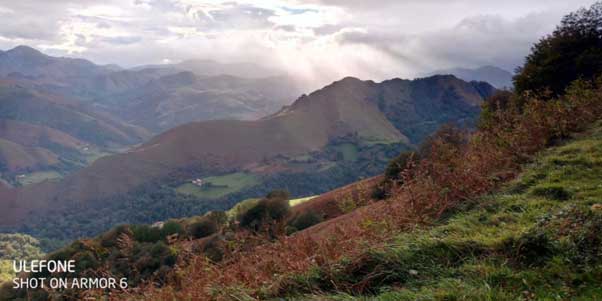
Alan Dearling talks to his friend, John Wilson, about his motivation for, and experiences of, the Camino de Santiago
But first a bit of background…it’s interesting stuff, but also a tad confusing…
The routes were originally created mostly by Catholic pilgrims, and the entire network is serviced by its own mix of municipal, voluntary and commercial hostels, campsites, hotels, businesses, tour companies and guides, eateries, plus support from many cathedrals and churches at the start of the routes and along the routes themselves. In 2022, nearly half a million walkers and cyclists finished the Camino to Santiago. ‘The Way’ has also become even more famous internationally through the film of the same name starring Martin Sheen
“The Camino de Santiago (the Way of St. James) is an extensive network of ancient pilgrim routes stretching across Europe and coming together at the tomb of St. James (Santiago in Spanish) in Santiago de Compostela in northwest Spain.
The most popular route (which gets very crowded in mid-summer) is the Camino Francés which stretches 780 km (nearly 500 miles) from St. Jean-Pied-du-Port near Biarritz in France to Santiago. This route is fed by three major French routes: the Voie de Tours, the Voie de Vezelay, and the Voie du Puy. It is also joined along its route by the Camino Aragones (which is fed by the Voie d’Arles, which crosses the Pyrenees at the Somport Pass), by the Camí de Sant Jaume from Montserrat near Barcelona, the Ruta de Tunel from Irun, the Camino Primitivo from Bilbao and Oviedo, and by the Camino de Levante from Valencia and Toledo.
Other Spanish routes are the Camino Inglés from Ferrol & A Coruña, the Via de la Plata from Seville and Salamanca, and the Camino Portugues from Oporto.
The network is similar to a river system – small brooks join together to make streams, and the streams join together to make rivers, most of which join together to make the Camino Francés. During the middle ages, people walked out of their front doors and started off to Santiago, which was how the network grew up. Nowadays, cheap air travel has allowed many to fly to their starting point and often to do different sections in successive years. Some people set out on the Camino for spiritual reasons; others find spiritual reasons along the Way as they meet other pilgrims, attend pilgrim masses in churches, monasteries, and cathedrals, and see the extensive infrastructure of buildings provided for pilgrims over many centuries.” Source: https://santiago-compostela.net/
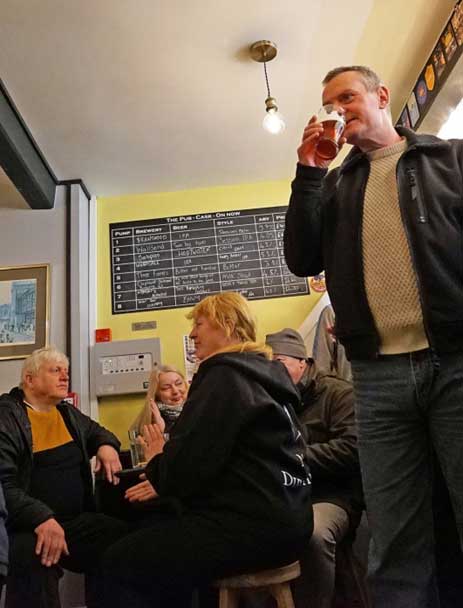
Alan: “Tell me a bit about the background to your decision to take some time out.”
John: “I’m not always very good at expressing myself, but by talking with you perhaps you could in a sense, be my ghost writer.
Any road-up, I was sat in ‘The Pub’ thinking to myself I’m finding life boring , not life in general but my life: I had a job, money in the bank, no debts, a car, a motorbike…so on the outside you would think I was doing OK. But there was something missing – don’t know what.”
Alan: “Why did you want to go on The Way?”
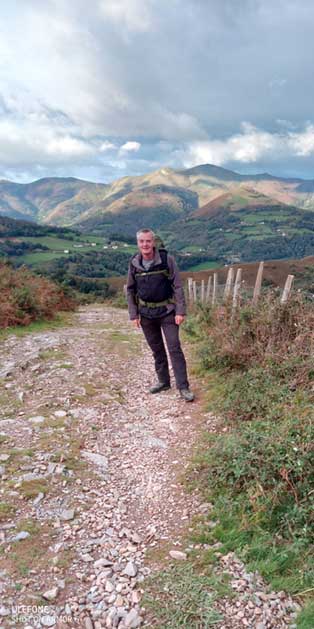
John: “I’d heard of the Camino several years before, a pilgrimage for religious people… I’m not religious in the slightest, but it always sparked an interest in me, so I thought that’s what I’m gonna do. The first day of the Camino I met many people who became good friends, some religious, some not, but all on the same journey for their own reasons. We walked many miles together, staying in hostels together, eating together, visiting churches (I couldn’t help but notice most of the art depicted people wearing military clothing and carrying weapons of war)… It got me wondering, if your man Jesus did come back, would he disown what’s become of his religion….?
It’s been a great experience. Has it changed my life? I’m not sure, but I don’t regret leaving my old life behind at all.”
Alan: “I gather that you became very much part of the ‘group’ that you met along The Way and that you made your decision to leave the trail because that’s what your companions were doing… Here’s what you told me at the time of that decision…”
John: “We arrived in St Jean Pied De Port at 13: 00 today …751km from my starting point of Le Puy En Velay… Well, we walked over the border to Spain today (Roncesvalles), then we got a taxi back to St Jean de Port ‘cos we are all going home tomorrow, might see you soon, missing English beer.”
Alan: “And a day later you contacted me saying that you were…”
John: “…At train station in St Jean de Port, 31 degrees centigrade, (very warm)… on the way to Paris, see you soon back in West Yorkshire.”
Alan adds as a kind of postscript:
I’d hoped to delve more into more of the nitty-gritty of John’s ‘adventure’. But, here’s a bit of what I found out during his fairly brief return to his old base in Yorkshire.
I know that John gave up his rented accommodation, his job, and sold his car and motor-bike before the trip.
Quite a radical set of decisions. He had bought maps for the route on the Camino de Santiago starting in France, fairly close to Paris. He’d tried out a walking pole and decided against using it, and he had found out a fair bit of advance information about the route and system of using the hostels for the pilgrims’ routes. Most of the walkers carry backpacks holding between 30 and 40 litres. More weight is likely to prove very painful and bad for the knees and feet and a further source of blisters! A way of choosing your most suitable backpack is to consider your own body-weight, fitness level and level of pre-training. Some of the ‘posh’, rich pilgrims use pre-booked accommodations and have their luggage transferred for them. John wasn’t one of them and told me that he hadn’t wanted to use any pre-booking of trains or hostels.
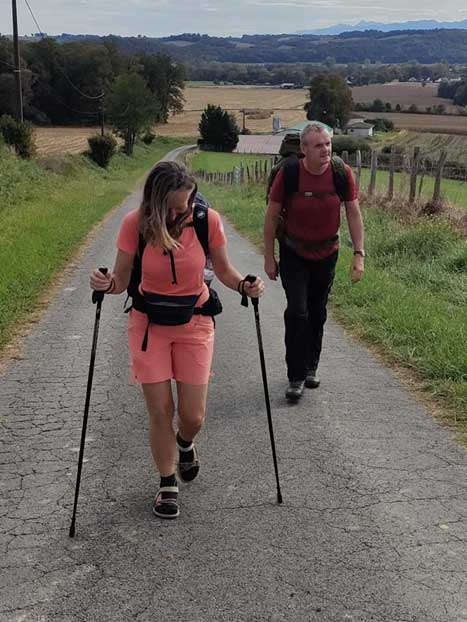
At the start, John needed to purchase a ‘credential’ to get accreditation/status as a Camino pilgrim which he had to get stamped at hostels, churches, eating places etc. I believe that this gets pilgrims into hostels at a cheap rate (about 10 euros a night, I believe)…
He obtained that at the beginning of his route in France at Le Puy En Velay.
Many folk on the Camino have made fairly negative comments about the noise, especially snoring in hostel dormitories…and even bed bugs. John also commented that it was often pretty difficult to get enough sleep. But most ‘pilgrims’ have commented upon, and enjoyed, a lot of the camaraderie, the chatting en route, new friendships and the social sessions in the hostels. The average daily target for walkers is between 20 and 25 km per day, though some only walk 10 km, some a lot more, and some actually run the route!
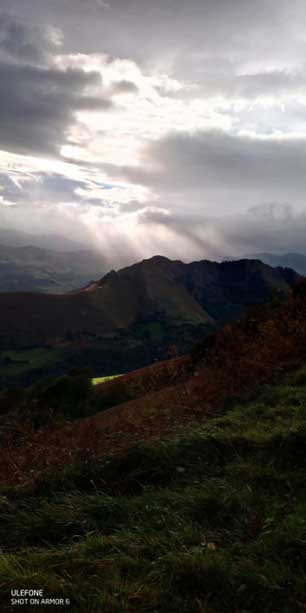
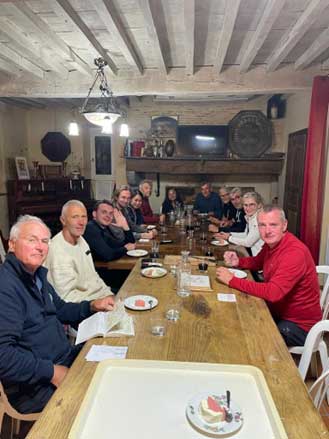
There is an enormous range of people by age and nationality who undertake the walk. The majority are from broadly Catholic countries. Pilgrims from the UK are relatively rare. In 2022, 438,683 people completed one of the many routes. Post-Covid more were expected on the Camino in 2023 and 2024. Nearly 95 per cent walk, but some use bicycles, travel on horseback, in wheelchairs and even have used sailboats.
John has definitely had a real ‘adventure’, an ‘experience’. He’s made some new close friendships. And it has provided lots of food for thought and consideration in planning for his options and future.
Alan: “Will you be going back to finish the Camino?”
John: “I definitely want to finish the final section of the Camino de Santiago…some of my friends are planning to go back in May 2024. I’m not sure yet, but I’d like to join them. I need to save up some money again.”
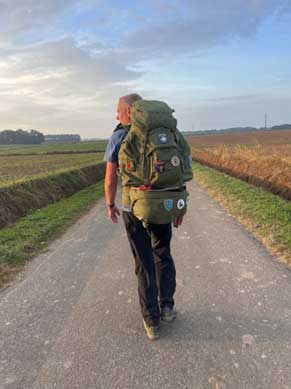
Here’s one useful on-line site offering more information and maps from the Camino trails:
